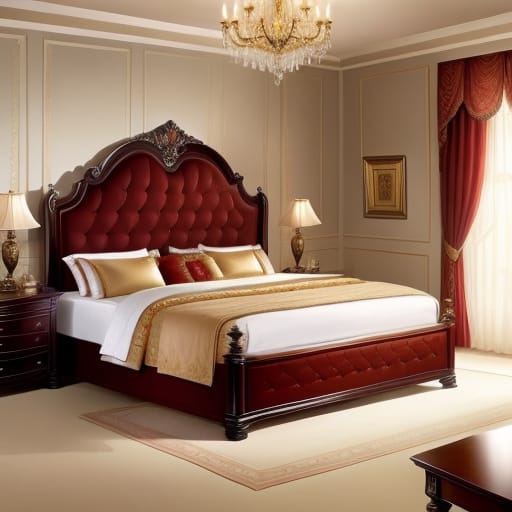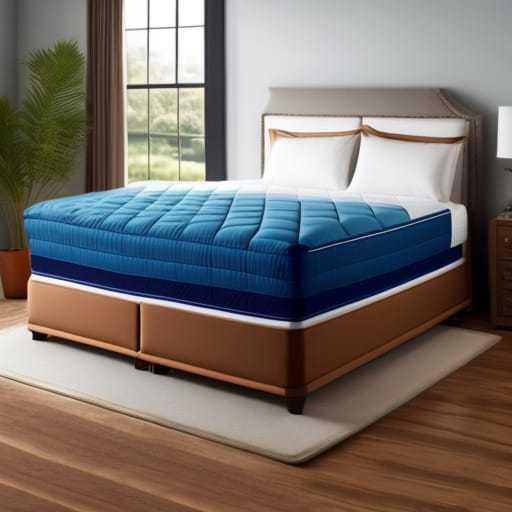Are you considering purchasing a down comforter but want to learn more about how they work first? This in-depth beginner’s guide will teach you everything you need to know before investing in that luxurious bedding upgrade.
What is a Down Comforter?
A down comforter is a type of quilt or duvet insert filled with the fine, fluffy clusters and plumules that insulate birds and waterfowl. This superior fill power keeps the comforter lofted to create space for body heat, allowing it to retain and circulate warmth exceptionally well.
Unlike down alternative comforters filled with polyester fibers, real goose or duck down offers unparalleled softness and breathability for a comforting night’s sleep.
A Brief History of Down Bedding
Down-filled bedding dates back thousands of years to the dawn of civilization when waterfowl hunting provided feathers for insulation.
By the 5th century BCE, the ancient Chinese were stuffing comfort items with kapok, the fluffy fiber encasing the seeds of the ceiba tree. Later Marco Polo recorded that the 13th century Mongolians had mastered the craft of quilting feather-stuffed blankets.
Down bedding became popular across Europe by the late Middle Ages. Continental comforters featured an outer shell with channels of feathers secured between two layers of fabric.
The artistry reached its peak in the Victorian era when elaborate stitch work embellished resplendent eiderdown coverlets and cushions.
Today advanced technology enables the production of superior bedding that maximizes the natural benefits of waterfowl down filling for comforters with remarkable warmth, softness and durability.
Why Choose the Right Down Comforter?
An excellent down comforter can make all the difference when it comes to getting a perfectly restful and restorative night’s sleep. As the essential top layer keeping you warm as you slumber, your comforter impacts these key factors:
✅ Body temperature regulation – Quality down allows enhanced breathability to prevent sweating while retaining warmth.
✅ ️Muscle relaxation – The cushiony surface cradles the body, enabling muscles to unwind completely.
✅ Joint comfort – Pressure points get cushy support, increasing circulation.
✅ Allergy help – Down resists dust mites and mold potentially aggravating allergies and asthma.
✅ Mood enhancement – Cozy comfort fosters serotonin production for reduced anxiety and depression.
Understanding Fill Power and Fill Materials
When it comes to down comforters, fill power and fill materials matter most for determining factors like warmth, weight, lifespan and price.
What is Fill Power?
Fill power indicates the loft or fluffiness of the down filling inside a comforter. It measures the cubic inches one ounce of compressed down fills when released from a cylinder.
Higher fill powers translate to more insulation per ounce. For example, 800 fill down means one ounce fills 800 cubic inches when lofted.
| Fill power | Quality |
|---|---|
| Under 500 | Low |
| 500-649 | Moderate |
| 650-799 | Good |
| 800-899 | Better |
| Over 900+ | Best |
The highest quality down with fill powers over 900 expands to fill over 900 cubic inches per ounce, creating thicker, more insulating loft.
Comparing Goose vs. Duck Down
Both duck and goose down can make exceptional comforters, but differences impact quality.
Goose down generally has higher fill power ratings, creating more loft. Geese live longer than ducks, giving their plumules more time to mature for better resilience and fill volume. The larger surface area of mature goose clusters traps more body heat.
Duck down tends to be heavier but less efficient at trapping warmth. However, improved processing technologies allow duck down to achieve excellent ratings too.
When combined in ideal percentages, duck and goose down complement each other well. Many comforters now feature custom down blends to optimize properties.
Down Alternative Fibers
For affordability or vegan/ethical reasons, many comforters now feature synthetic down alternative fill made from fibers like:
- Polyester – Polyester microfibers twisted to mimic down clusters. Budget-friendly option.
- PrimaLoft®️ – Fine microfibers with excellent warmth-to-weight ratios. Often blended with down.
- Silk – Shredded silk fibers create lush filling. Relatively eco-friendly.
- Kapok – Organic silk-cotton tree fibers with hollow centers. Natural hypoallergenic choice.
- Wool – Renewable temperature-regulating wool makes cozy comforters.
With advanced fiber technologies, the best down alternative comforters nearly match pure down’s softness and temperature control. However, they rarely outperform high-end goose down’s resilience and longevity.
Down Comforter Construction
From outer fabric shell to inner fill distribution, comforter construction elements impact quality, warmth and durability.
Outer Fabric Shell
The outer shell encasing the down fill plays a crucial role. Ideal fabrics will:
✅ Feel soft against skin
✅ Allow good airflow and moisture wicking
✅ Keep down evenly distributed
✅ Resist leaking tiny feathers
Cotton, cotton-polyester blends, and poly-microfiber fabrics balance durability, breathability and affordability.
Luxury options like sateen offer exceptionally sophisticated textures. Percale woven tightly with fine combed yarns enhances breathability.
For budget options, polyester works better than cheaper twills prone to snagging.
Inner Fabric Layers
Within its outer shell, a comforter contains several inner fabric layers:
Outer shell – Provides comfort next to skin. Often decoratively patterned.
Inner lining – Protective barrier keeping fill in place. Needs good permeability.
👉 Baffle box – Square fabric compartments spread fill evenly across.
👉 Sew lines – Attach outer and inner layers to prevent shifting.
Loops/ties – Connect to duvet corners to prevent sliding.
Fill Distribution Methods
Feather-light down requires advanced construction to keep it evenly distributed. 3 key techniques:
1. Sewn-through box stitching
The entire comforter gets divided into small, rectangular baffle boxes by stitching the outer shell to inner lining. This keeps fill spread evenly and prevents clumping.
2. Baffle box construction
Box walls made of fabric go between the outer shell and lining to create larger separated chambers for holding down. This allows maximum lofting.
3. Channel construction
Vertical fabric channels run between the top and bottom surfaces to distribute fill. This allows down to fully expand and circulate heat efficiently.
Channel construction often proves optimal for achieving consistent fluffiness from edge to edge.
Down Comforter Certifications
With global supply chains, customers rightly want assurances about ethical sourcing and product safety. Trustworthy certifications to look for include:
Responsible Down Standard (RDS)
The global RDS audits and certifies companies secularly procuring down without live-plucking or force-feeding. Brands like Patagonia and REI now feature RDS-approved down. This independent certification verifies humane practices.
OEKO-TEX Standard 100
This certification ensures tested textiles meet stringent safety criteria for substance levels and pH balance. Any harmful chemicals from dyes, pesticides or coatings get detected, making OEKO-TEX approval a must for bedding.

Factors to Consider When Choosing a Down Comforter
Fill Power Level
Higher fill powers around 800+ optimize loft and warmth, but cost more. Sleep temperature preferences factor too. Hot sleepers can opt for lower fills or summer-weight options.
Fabric Shell Quality
Thread counts under 200 can feel scratchy. Ideally choose smooth, breathable cotton sateen or microfiber with a 300-500 thread count. Checks for tight, durable stitching.
Size
Choose comforters to fit your mattress size. Twin and Full work for children/guest rooms while King suits master bedrooms. Oversize Queen offers the best fit flexibility.
Colors and Patterns
White goose down keeps options versatile to match all decors. Baffle-box construction allows ornate floral prints, elegant solids like chocolate or ivory, plus striped ticking.
Benefits of Down-Filled Comforters
Lightweight Fluffiness
Superior down offers the highest warmth-to-weight ratio of any insulator. Don’t be fooled by seemingly thin profiles, as less material traps more heat. Lifting with only feather-light heft, down comforters float over sleepers like a fluffy cloud.
Temperature Control
The unbeatable breathability of down keeps sleepers comfy through any season. Air easily circulates through the tiny clusters. Heat gets trapped during the night, then released when temperatures rise to prevent perspiring.
Long Lasting Quality
With lofty resilience and durability measured in decades, the longest lasting comforters feature high fill power down encased in quality fabrics. Responsible maintenance preserves longevity.
Who Stands to Benefit Most From a Down Comforter?
Allergy Sufferers
Thanks to exceptional breathability and hypoallergenic properties, down comforters allow excellent airflow to deter dust mites. Proper encasement also prevents feathers from escaping through tiny holes to trigger allergies.
Hot Sleepers
If night sweats or hormonal changes cause your internal thermostat to surge, down helps regulate temperatures. Superior breathability releases built-up heat from small fabric pores to keep you dry and comfortable without chilling.
Luxury Lovers
Nothing matches the sensory enjoyment of snuggling under fine European down bedding. The enveloping feel nurtures the soul while enhancing restfulness. For those craving a sybaritic sleep experience that pampers the body, down delivers.
How Do Different Down Comforters Compare?
As a high-end investment, it helps to understand the performance range across down comforter types.
| Parameter | Luxury Hotel Collection | Pacific Coast Luxury | White Goose Down |
|---|---|---|---|
| **Fill Material ** | 850 Fill Power White Goose Down | 600 Fill Power White Duck Down | 75/25 White Goose/Duck Down |
| **Fill Weight ** | 60 oz | 60 oz | 60 oz |
| Fabric Shell | 400 TC cotton sateen | 300 TC cotton | 300 TC cotton |
| Dimensions | Up to Oversize King | King, Queen, Standard | Queen |
| Price | $$$ | $$ | $ |
| Lifespan | 25+ years | 10-15 years | 5-7 years |
| Benefits | Prestige quality | Better resilience | Budget friendly |
This table shows how higher fills and thread counts impact durability and pricing across the spectrum. Customers aiming for heirloom longevity could consider investing in 800+ fill powers encapsulated in quality sateen. However excellent year-round comforters are available at more accessible price points too.
Understanding Outer Shell Fabrics
Why Does Thread Count Matter?
Higher thread counts using fine, densely woven yarns create more durable, pill-resistant fabric with enhanced breathability. For ultimate longevity, look for a 350+ count sateen or percale shell.
What About Hypoallergenic Fabrics?
Allergens and asthma triggers cling to bedding easily. However, finely woven cotton, microfiber or silk paired with purified down resists irritants. Oeko-Tex certification guarantees fabric safety.
Down Comforter Care and Cleaning
To keep a down comforter fresh, fluffy and evenly filled for years:
1. Use a duvet cover – This protective barrier keeps body oils and spills from soiling the comforter shell.
2. Air out frequently – Hang in breezy sunlight to renew loft and dissipate humidity.
3. Spot clean stains – Use a mild detergent, distilled water and soft brush to gently dab out soiled spots.
4. Professionally launder annually – Most household machines agitate too roughly. Find a specialty cleaner experienced with down.
5. Store properly when not in use – Refold along original seams and lines without compression to preserve loft.
Avoid topping folded comforters with anything heavy.
The Link Between Quality Sleep and Productivity
While more research continues emerging, early studies indicate sleep efficiency enables superior functioning:
- Well-rested employees concentrate better with nearly 60% higher productivity rates, according to research published in the Journal of Vocational Behavior.
- Workers getting just 90 extra minutes of nightly sleep sharpened skills like cognition, task focus and emotional stability by over 30%, as per a University of Michigan study.
This suggests quality comforters can boost productivity by nurturing more restorative sleep. Investing in the best bedding within reasonable budgets makes good sense for well-being and daily performance.
“A good down comforter ensures you stay cozy and regulated all night for waking up refreshed and ready to be your best self the next day.” – Dr. Rebecca Robbins, Sleep Researcher, Brigham and Women’s Hospital
Consumer Impressions and Reviews
“I didn’t expect to feel such a difference after buying a down-filled comforter insert for my duvet. The fluffy fill is so soft and warm but breathable. I used to overheat and get night sweats. Now I sleep through without tossing and turning. It was worth the price for better rest.”
Emma T. from Brooklyn, NY
Customers note the remarkable comfort-to-weight ratio makes even low-fill down feel heavenly. Hot sleepers report better temperature regulation while side sleepers note pressure relief. Many mention the emotional pick-me-up lavishing in luxurious bedding provides after a stressful day.
Ethical and Environmental Considerations
Seeking down from ethically-managed sources minimizes harm:
1. Choose RDS-certified materials legally sourced as by-products from the food industry without animal cruelty. This influences sourcing practices industry-wide.
2. Support innovative new humane standards like the Downpass Certification Program which audits animal welfare across the supply chain.
3. Understand traceability information like QR codes so customers can lookup region-specific ethical sourcing details.
Recent Innovations Advance Down Tech
- Hyperfine filtration by UltraClean®, DOWN3® and others maximizes fluffiness from premium down using advanced air separators, magnets and sieves without added chemicals.
- SmartLAYER® technology pioneered by ThermoregTM optimizes heat circulation across comforters for responsive, breathable warmth.
- ALATEXTM fabric technology opens adjustable cross-venting valves to rapidly cool overheated sleepers using the body’s moisture level signals.

Conclusion: Which Down Comforter Should You Choose?
When chosen with care and understanding about construction, sourcing and materials, few bedding upgrades impart the transformative sense of peace and luxury found drifting beneath the light-as-air canopy of a quality down comforter.
Frequently Asked Questions
What is the warmest down comforter fill power?
The warmest down comforters feature fill powers over 800 to create maximum loft and insulation. Premium goose down around 900-950 fill traps the most heat for frigid climates. For more moderate weather, 600-650 fill should sufficiently retain warmth.
What thread count is best for a down comforter?
Ideally look for a thread count between 300-500 using quality combed cotton or ultra-fine microfiber yarns. Counts over 500 can feel excessively stiff while numbers under 300 tend to wear out and tear more quickly over time. Durable 400 thread count sateen optimizes both longevity and breathability.
How much does a good down comforter cost?
The highest quality down comforters with 800+ fill power, baffle box construction and 400 thread count cotton shells range from $400 to $1200 for a Queen size. Well-made comforters with duck down blends around 600 fill power and decent 300 thread count shells run $100 to $300 usually.
How often should you replace a down comforter?
With proper care and maintenance like using a duvet cover, spot cleaning, and airing out frequently, you can enjoy a quality down comforter for 15 to 25 years. Higher fill powers around 800+ last the longest. Check stitching regularly for loose threads to re-secure and extend lifespan.
What’s the difference between down and down alternative comforters?
True down comforters contain clusters of fluffy goose or duck plumules that provide unparalleled insulation, breathability, durability and comfort. Down alternative comforters use polyester or other synthetic fills to mimic properties of down at lower price points, but usually can’t match the same level of lasting performance.








